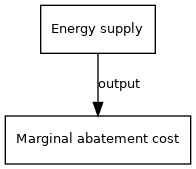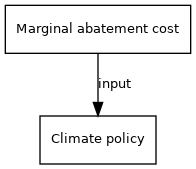Marginal abatement cost: Difference between revisions
Jump to navigation
Jump to search


ElkeStehfest (talk | contribs) No edit summary |
No edit summary |
||
| Line 1: | Line 1: | ||
{{VariableTemplate | {{VariableTemplate | ||
|Label=Marginal abatement cost | |Label=Marginal abatement cost | ||
|ShortDescription=Cost of | |ShortDescription=Cost of an additional unit of pollution abated (CO2eq). A marginal abatement cost curve (MAC curve) is a set of options available to an economy to reduce pollution, ranked from the lowest to highest additional costs. | ||
|Description=The cost of one additional unit or ton of pollution (here CO2eq) that is abated. A marginal abatement cost curve (or MAC curve) is a set of options available to an economy to reduce pollution ranging from the lowest to highest additional costs. | |Description=The cost of one additional unit or ton of pollution (here CO2eq) that is abated. A marginal abatement cost curve (or MAC curve) is a set of options available to an economy to reduce pollution ranging from the lowest to highest additional costs. | ||
|Dimension=time, region | |Dimension=time, region | ||
Revision as of 11:52, 6 May 2014
| Label: | Marginal abatement cost |
| Short description: | Cost of an additional unit of pollution abated (CO2eq). A marginal abatement cost curve (MAC curve) is a set of options available to an economy to reduce pollution, ranked from the lowest to highest additional costs. |
| Description: | The cost of one additional unit or ton of pollution (here CO2eq) that is abated. A marginal abatement cost curve (or MAC curve) is a set of options available to an economy to reduce pollution ranging from the lowest to highest additional costs. |
| Dimensions: | time, region |
| Default unit: | $/GJ |
| Variable type: | model (from/to model) |
Variable is output of model component:

Variable is input of model component(s):

- Click on a box to open the model component.